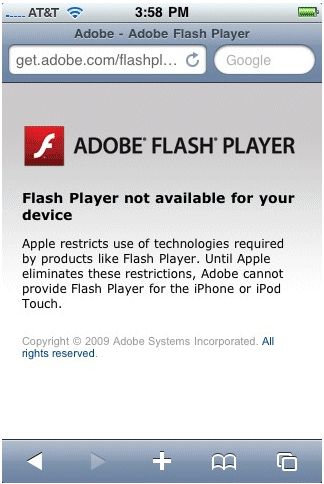We got a few more clues about Adobe’s iPhone problem at a press conference today with Chief Technology Officer Kevin Lynch. There is no doubt about the importance Adobe attaches to the device. “Flash needs to get there in order to stay relevant on the web”, says Lynch, though there was some ambiguity about whether he meant the iPhone specifically, or the mobile web in general.
Yesterday’s announcement of Applications for iPhone, a feature of the forthcoming Creative Suite 5, solves a problem for developers wanting to port Flash applications to iPhone apps for Apple’s App Store, but does nothing for Flash content in web pages. Here’s the page you get if you follow a “Get Flash” link using an iPhone:

Note Adobe’s slightly more aggressive wording in the latest version of this page: “Until Apple eliminates these restrictions, Adobe cannot provide Flash Player for the iPhone.”
So what if Apple continues to refuse Flash – something which some users would actually welcome? Lynch made reference to the number of hot new Smartphones now appearing, including Palm Pre, Android phones, Windows Mobile 6.5 phones, and Nokia’s latest devices. He then referenced the early history of the PC, when Apple was first to market with a mouse-driven GUI but lost out to Windows in the mass market, and suggested that history might repeat itself, as these new devices incorporate many of the features for which the iPhone is popular.
The implication is that if Apple continues to be Flash-free it might lose market share to others; and that this might happen anyway thanks to the iPhone’s premium price and closed platform.
This may be wishful thinking. Closed or not, Apple has built up impressive third-party support for the iPhone and it will be hard to tempt existing users away.
Still, in the absence of any other possible strategy, it’s a reasonable one to try. We will not know the impact of having the full Flash player on Smartphones for a while yet, but if it successful, more of Apple’s customers will ask for Flash to be supported.

